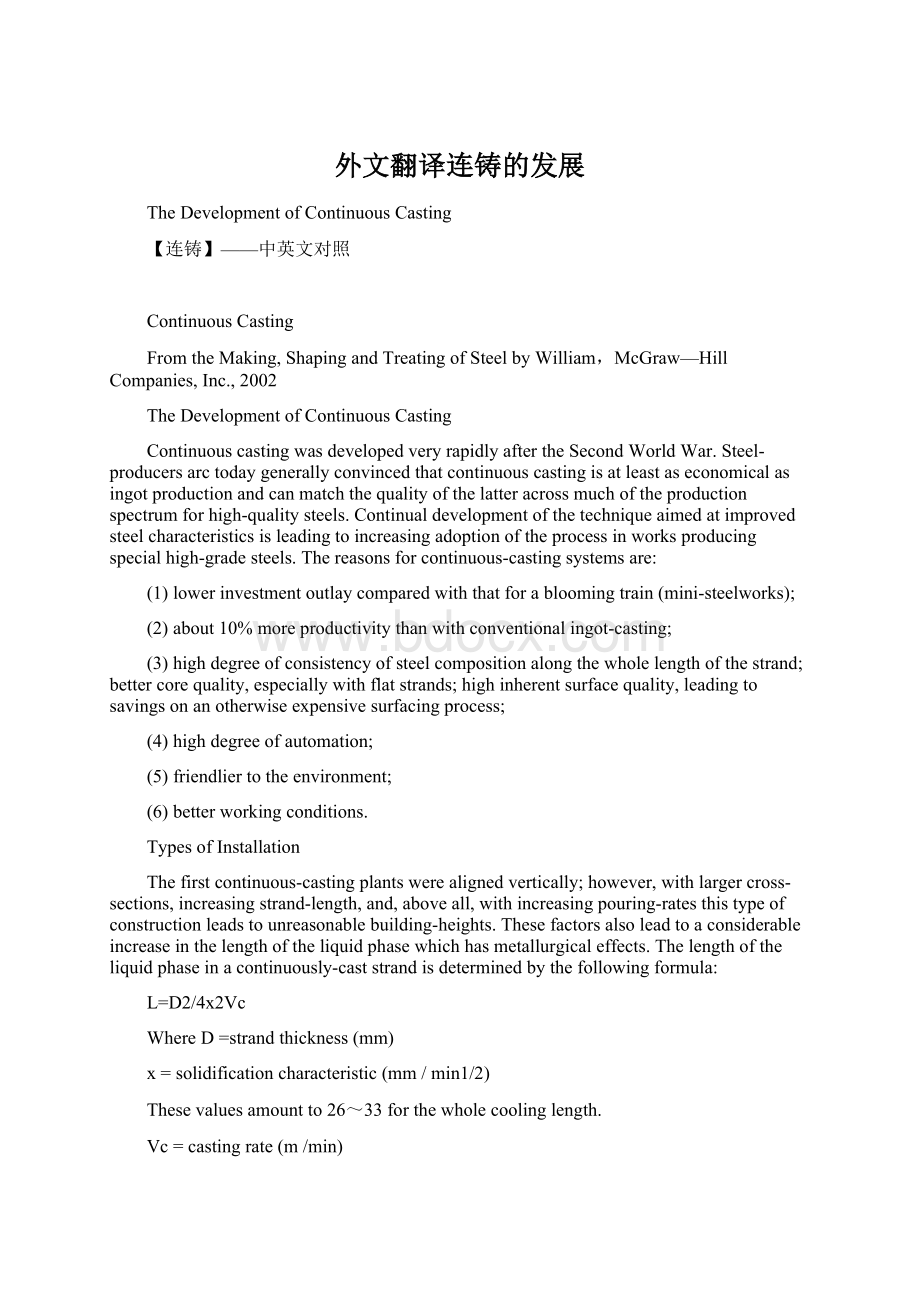外文翻译连铸的发展.docx
《外文翻译连铸的发展.docx》由会员分享,可在线阅读,更多相关《外文翻译连铸的发展.docx(13页珍藏版)》请在冰豆网上搜索。

外文翻译连铸的发展
TheDevelopmentofContinuousCasting
【连铸】——中英文对照
ContinuousCasting
FromtheMaking,ShapingandTreatingofSteelbyWilliam,McGraw—HillCompanies,Inc.,2002
TheDevelopmentofContinuousCasting
ContinuouscastingwasdevelopedveryrapidlyaftertheSecondWorldWar.Steel-producersarctodaygenerallyconvincedthatcontinuouscastingisatleastaseconomicalasingotproductionandcanmatchthequalityofthelatteracrossmuchoftheproductionspectrumforhigh-qualitysteels.Continualdevelopmentofthetechniqueaimedatimprovedsteelcharacteristicsisleadingtoincreasingadoptionoftheprocessinworksproducingspecialhigh-gradesteels.Thereasonsforcontinuous-castingsystemsare:
(1)lowerinvestmentoutlaycomparedwiththatforabloomingtrain(mini-steelworks);
(2)about10%moreproductivitythanwithconventionalingot-casting;
(3)highdegreeofconsistencyofsteelcompositionalongthewholelengthofthestrand;bettercorequality,especiallywithflatstrands;highinherentsurfacequality,leadingtosavingsonanotherwiseexpensivesurfacingprocess;
(4)highdegreeofautomation;
(5)friendliertotheenvironment;
(6)betterworkingconditions.
TypesofInstallation
Thefirstcontinuous-castingplantswerealignedvertically;however,withlargercross-sections,increasingstrand-length,and,aboveall,withincreasingpouring-ratesthistypeofconstructionleadstounreasonablebuilding-heights.Thesefactorsalsoleadtoaconsiderableincreaseinthelengthoftheliquidphasewhichhasmetallurgicaleffects.Thelengthoftheliquidphaseinacontinuously-caststrandisdeterminedbythefollowingformula:
L=D2/4x2Vc
WhereD=strandthickness(mm)
x=solidificationcharacteristic(mm/min1/2)
Thesevaluesamountto26~33forthewholecoolinglength.
Vc=castingrate(m/min)
Effortstoreducebuilding-heightfirstledtocontinuous-castingsystemsinwhichmoltenmetalpassedintoaverticalmouldandsolidifiedcompletelybeforebeingbentorwherethestrandhasbeenintheliquidphaseandlatertothebow-typeinstallationwhichhasacurvedmouldandisthesystemmostusedtoday.Verticalsystemsandthoseinwhichthestrandisbentwhencompletelysolidifiedhavelongstraightliquidphasesandcanleadtounacceptablyhighcapitaloutlay.
However,thesesystemshavemetallurgicaladvantagesfromthepointofviewofmaintenance.Averticalsysteminwhichthestrandisbentwhilestillintheliquidphasehastheadvantagethatthebuildingneednotbeastallaswhenthestrandisbentaftersolidification;however,theliquid-phasebendingsystemrequireshigherinitialoutlayandgreatermaintenancecosts.Thebow-typesystemrepresentsacompromisebetweenthecostsofcapitaloutlayandofmaintenanceandwhatcanbeachievedmetallurgically.
Continuous-castingissuitablefortheproductionofalmostanycross-sectionimaginable;square,rectangular,polygonal,round,andovalsectionsareallavailable.Therearealsosomeinstancesofpreliminarysectionsfortubesandslabs,blooms,andbillets.Sectionswithabreadth/thicknessratiogreaterthan1.6arenormallydescribedasslabs.Billet-machinesproducesquareornearly-square,round,orpolygonalcross-sectionsupto160mmacross.Largersectionsandthosewithabreadth/thicknessratiolessthan1.6arecastinbloom-machines.Billetsnowadaysnormallyproducedinthiswayrangefrom80x80to300x300mm,andslabsare50-350mmthickand300-2500mmwide.
Continuous-castingoutput-rateshaverisensharply,especiallyinthelastfewyears.Thisisessentiallybecauseofincreaseinthebreadthofthestrandandincastingrate.Thefollowingoutputshavebeenexceededpersectionperminute:
slabs5tonesblooms1tonesbillets350kg
Finally,weshouldmentionhorizontalcontinuous-castingsystemswhicharealreadyusedfornon-ferrousmetalsandcastironandwhicharebeingfurtherdevelopedforsteel.R.ThieimannandR.Steffenhaveproducedacomprehensivereportaboutthestateofdevelopmentofhorizontalcontinuous-castingsystemsforproducingbilletsfromunalloyedandalloysteels.Horizontalcontinuous-castingsystemshavethreeimportantadvantagesoverconventionalcontinuous-castingsystem:
(1)lowheightandcostofbuilding;
(2)simplemeansofprotectingthemeltagainstreoxidatioin;
(3)nostranddeformationbecausetheferrostaticpressureismuchlower.
CastingTechnique
Moltensteelispouredfromacastingladleviaatundishintoanopenwater-cooledcoppermould.Atfirstthebottomofthemouldisclosedoffbyastarting-bar,whichthenleadstransportofthehotstrandfromthemouldintothecontinuouswithdrawingrolls.Thestrand,whichstartstosolidifyinthemould,passesthroughacoolingsystembeforeitfinallyreachesthewithdrawingrolls,whereuponthehotstrandtakesovertransport.Thestarting-barisseparatedfromthehotstrandbeforeorafteritreachesthepartingdevice.Thelatter,whichmayeitherbeaflame-cutterorhotshears,movesatthesamerateasthehotstrandandcutsitintothelengthsrequired.
Thepurposeofthetundishistofeedadefinedquantityofmoltensteelintooneormoremoulds.Thiscanbedonebyusingnozzlescontrolledbystoppers,slide-gates,orothermeans.Thetundishmayinitiallybecold,warm,orhotaccordingtothenatureofitsrefractorylining.Wheredifficultsteelsareprocessedthepouringstreamisprotectedagainstoxidationbetweenthesubmergedboxes.Themouldnotonlyformsthestrandsectionbutalsoextractsadefinedquantityofheat,sothatthestrandshellisstrongenoughfortransportbythetimeitreachesthemould-outlet.Themouldmaybemadefromcoppertubeorhardenablecopperalloy,dependingontheshapeandsizeofthestrandtobecast.Asarule,tubularmouldstireusedforsmallersections.Theinteriorsurfaceofthemouldmaybecoatedwithchronicormolybdenumtoreducewearandtosuitheat-transferfromthealloybeingcast.Themouldistaperedtomatchsteel-shrinkageandcasting-rateandthetypeofsteelconcerned.Mouldsusedtodayrangefrom400to1200mminlengthoverall,buttheirusuallengthisbetween700and800mm.Theproblemofsteeladheringtothemould-sidesisusuallycounteredbyoscillatingthemouldsinusoidallyrelativetothestrandandbyaddinglubricant(oilorcastingflux}inanattempttocutfrictionbetweenthemouldandthesteel.Thelubricant,particularlycasting-flux,hasanadditionalmetallurgicalfunction.Thechoiceoflubricantdependsonthequalitiesrequiredandthecastingconditions;itisparticularlyimportantthatcasting-fluxshouldbechosentomatchthequality-programmeprecisely.
Thelevelofsteelinthemouldmaybecontrolledmanuallyorbyanautomaticsystem.Eithermethodmaybeusedtokeepthelevelconstantortomatchtheincomingmoltensteel,i.e.toaccommodatevariationsincastingrate.Manualcontrolisaffectedviathestopperinthetundishorbyvaryingtheoutputrate.Anautomaticcontrolsystemmaymeterradioactivityorinfraredradiationormeasuretemperatureviaaprobeinthemouldwalltodeterminethesteel-levelandcompensateanychangesbyactuatingthestopper-mechanism(forconstantpouringrate)orcontrollingthespeedofthewithdrawingrolls(varyingcastingrate).
Thetypeofstarting-barusedforcontinuous-castingdependsonthetypeofinstallation.Rigidstarting-barscanbeusedinverticalsystems,whilearticulateddummybarsorflexiblestriphavetobeusedinbowedinstallations.Thestartingbarcanbeconnectedtothehotstrandindifferentways,oneisbyweldingthefluidsteelusingajointingelement(flatslab,screw,orfragmentofrail)whichissolubleinthestarting-bar;anotherisbycastingtheconnectorinaspeciallyshapedheadinthedummybarinawaythatenablesittobereleasedbyunlatching.
Thethicknessofthesolidifiedstrandshellonleavingthemoulddependsfirstofallonhowlongthesteelisincontactwiththemould,butitalsodependsonthespecificthermalconductivityofthemouldandontheamountofsuperheatthatsteelhaswhenitentersthemould.Itcanbedeterminedwithfairaccuracyusingthefollowingparabolicformula:
C=x.T
whereCisthethicknessofthestrandshell(mm)
xisthesolidificationcharacteristic(mm/min1/2)
tisthesolidificationtime(min)
Thesolidificationcharacteristicinandnearthemouldliesbetween20and26,dependingontheoperatingconditions;forthesecondarycooling-areathefigureis29-33.Thethicknessofthesolidifiedstrandshellonleavingthemouldisabout810%ofthestrand-thickness,dependingoncastingrate.Asecondarycooling-areaunderthemouldspeedsupcompletionofthesolidificationprocess.Thecoolantusuallyiswaterbutawater/airmixtureorcompressedairisalsosometimesused.Thesecondarycoolingareaisdividedintoseveralzonestosuitcoolantflowrates.Thenecessaryquantityofwaterissprayedovertheentirestrandbyspray-bars.Theferrostaticpressuremaybesohighinrelationtothestrandcross-sectionandthecastingratethatthestrandhastobesupportedtopreventbuckling.Theequipmentforthisisexpensiveinplantsproducingbloomsandespeciallyslabs.
ProcessControl
Forproductivityandqualityreasonsthereisatrendinmodernsteelmakingtotransfertime-consumingoperations,suchastemperatureadjustment,deoxidationandalloying,fromthefurnacetotheladletreatmentstations.Thesetreatmentsareparticularlyimportantwherethecontinuouscastingprocessisinvolvedbecausetemperatureandcompositionmustcloselybecontrolled.
Thetemperaturecontrolofmoltensteelasitentersthemouldnee